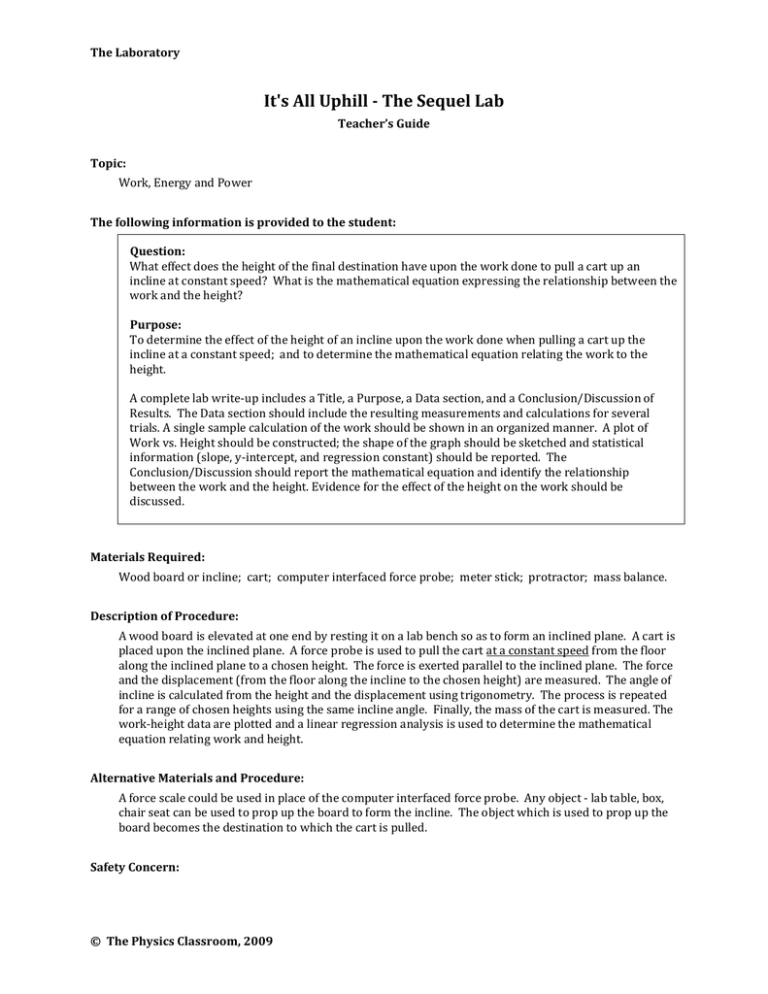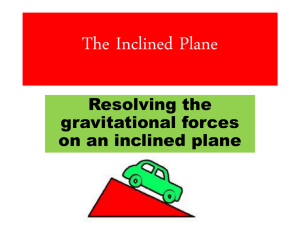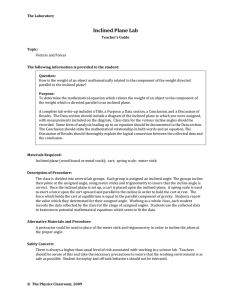It's All Uphill - The Sequel Lab
advertisement

The Laboratory It's All Uphill - The Sequel Lab Teacher’s Guide Topic: Work, Energy and Power The following information is provided to the student: Question: What effect does the height of the final destination have upon the work done to pull a cart up an incline at constant speed? What is the mathematical equation expressing the relationship between the work and the height? Purpose: To determine the effect of the height of an incline upon the work done when pulling a cart up the incline at a constant speed; and to determine the mathematical equation relating the work to the height. A complete lab write-up includes a Title, a Purpose, a Data section, and a Conclusion/Discussion of Results. The Data section should include the resulting measurements and calculations for several trials. A single sample calculation of the work should be shown in an organized manner. A plot of Work vs. Height should be constructed; the shape of the graph should be sketched and statistical information (slope, y-intercept, and regression constant) should be reported. The Conclusion/Discussion should report the mathematical equation and identify the relationship between the work and the height. Evidence for the effect of the height on the work should be discussed. Materials Required: Wood board or incline; cart; computer interfaced force probe; meter stick; protractor; mass balance. Description of Procedure: A wood board is elevated at one end by resting it on a lab bench so as to form an inclined plane. A cart is placed upon the inclined plane. A force probe is used to pull the cart at a constant speed from the floor along the inclined plane to a chosen height. The force is exerted parallel to the inclined plane. The force and the displacement (from the floor along the incline to the chosen height) are measured. The angle of incline is calculated from the height and the displacement using trigonometry. The process is repeated for a range of chosen heights using the same incline angle. Finally, the mass of the cart is measured. The work-height data are plotted and a linear regression analysis is used to determine the mathematical equation relating work and height. Alternative Materials and Procedure: A force scale could be used in place of the computer interfaced force probe. Any object - lab table, box, chair seat can be used to prop up the board to form the incline. The object which is used to prop up the board becomes the destination to which the cart is pulled. Safety Concern: © The Physics Classroom, 2009 The Laboratory There is always a higher than usual level of risk associated with working in a science lab. Teachers should be aware of this and take the necessary precautions to insure that the working environment is as safe as possible. Student horseplay and off-task behaviors should not be tolerated. Suggestions, Precautions, Notes: 1. 2. 3. 4. The force can be measured in any equilibrium situation - pulling the cart up the inclined plane at a constant speed or holding the cart at rest. It is very common for students to use the incline angle as the value in the W = F•d•cos. The value in the equation is the angle between the F and the d vectors - 0° in this lab. Drawing a diagram on the board and labeling the F and the d vector parallel to the inclined plane helps students to overcome this hurdle. Results are very convincing of the conclusions that the force and inclined angle are directly related and that the work is the same value despite changes in the incline angle. The measurement of the mass of the cart makes it possible to calculate the potential energy change and compare it to the average value of the work (a post-lab activity). Help students to relate the experiment to the theoretical expectation. At a constant speed, the applied force is equal to m•g•sin and the displacement is ∆h/sin. Putting this together, the work is W = F•d = (m•g•sin)•(∆h/sin) = m•g•∆h W = k•∆h where k = m•g Knowing the mass of the cart, the theoretical constant of proportionality can be calculated and compared to the slope of the line. Auxiliary Materials: None Scoring Rubric: E2. It’s All Uphill – The Sequel Lab Included, labeled and organized all parts of the lab report. Data section includes a table of collected and calculated data organized in rows and columns; units are indicated. A sample calculation is shown for each type of calculation. Data is reasonably accurate. A plot of work vs. height is sketched; slope, y-intercept and regression constant are reported. Conclusion/Discussion reports the equation relating work and height and describes the qualitative relationship. Reference is made to the data and graphical information in an effort to support the conclusion. Connections to The Physics Classroom Tutorial: The following readings are a suitable accompaniment to this lab: http://www.physicsclassroom.com/Class/energy/u5l1a.cfm http://www.physicsclassroom.com/Class/energy/u5l1aa.cfm Connections to Minds on Physics Internet Modules: Sublevel 1 of the Work and Energy module is a suitable accompaniment to this lab: http://www.physicsclassroom.com/mop/module.cfm © The Physics Classroom, 2009 Score _____/_____



